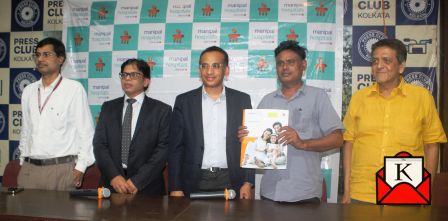Discussion On Rising Cases Of Liver & Gastric Diseases In Eastern India


In recent years, liver disease cases have risen sharply in India. Fatty liver disease is a major cause for concern, particularly in the Eastern and North East region. One in five people now has liver disease, which is spreading like wildfire. A stunning 268,580 liver-related deaths occur in India each year, accounting for 3.17 percent of all deaths and 18.3 percent of the 2 million liver-related deaths worldwide.
In light of this, Manipal Hospital Old Airport Road held a press conference to discuss the worrisome growth in liver disorders in the Eastern and North Eastern parts of India.
The conference was graced by Dr. Rajiv Lochan, Lead Consultant – HPB and Liver Transplantation Surgery, Manipal Hospital Old Airport Road, and Dr. Raj Vigna Venugopal, HOD & Consultant – Medical Gastroenterology, Manipal Hospital Old Airport Road.
The high frequency of viral hepatitis, especially hepatitis B and C infections, plays a significant role in the development of liver disorders and liver damage in India. Alcohol misuse, which results in fatty liver disease and is especially common in the Eastern and North-Eastern region, is another important component in the development of liver damage. While smoking raises the risk of liver cancer, heavy drinking leads to alcoholic liver disease. diseases spread by tainted food, water, and blood products can all result in chronic liver inflammation and damage over time, necessitating liver transplants. These diseases are also brought on by rural environments.
It can be challenging to detect pancreatic diseases such as gastric cancer, duodenal ulcers, pancreatitis, and gallstones since symptoms like acidity might be related to a wide range of illnesses. Environmental factors like alcohol usage, gallbladder stones, a poor diet, and a lack of physical activity frequently contribute to the development of these disorders.
Dr. Raj Vigna Venugopal said that gallbladder and pancreatic disorders are common among patients in Eastern and North Eastern India, with gallbladder and bile duct stones being the most frequent symptoms. Tropical pancreatitis, a disorder in which the pancreas develops stones, is also common in the area and requires a comprehensive strategy for treatment, which their team is well-equipped to deliver. As the liver plays a crucial role in digesting nutrients and filtering toxins from the digestive system, pancreatic illnesses are a substantial contributor to liver issues. In order to identify the underlying cause and administer prompt therapy for stones, it is imperative to look into patients who have prolonged symptoms. Severe consequences like jaundice and sepsis could result from failing to do this.

Dr. Rajiv Lochan placed a strong emphasis on the requirement for more knowledge and instruction regarding the significance of early diagnosis and treatment. He said, “Early detection is crucial because liver cancer is one of the main causes of cancer-related death in India. Since the liver is the largest internal organ, it frequently takes 60–70% liver damage before a disease is recognized. Numerous patients who need transplants come to us in advanced stages. They are frequently placed on dialysis and on the transplant waiting list. Therefore, it is strongly advised that persons with a history of liver illness or risk factors undergo frequent testing for hepatitis B and C as well as regular checkups. Adopting a healthy lifestyle and getting frequent checkups are also essential to preventing the development of liver ailments”.
The largest liver transplant program in Karnataka, Manipal Liver Care Unit, offers complete liver care services. The Manipal Liver Care Unit has successfully completed 64 transplants in the past year alone, with a success rate of 94.5%. It includes living donor transplants for children as young as seven months and as old as 74. They have performed over 70 major liver reactions and are the only facility to perform robotic donor hepatectomy. The unit is manned by a group of highly skilled and experienced professionals, including hepatologists, intensivist anesthesiologists, surgeons, nurses, and technicians, and is outfitted with the most recent robotic-assisted equipment.
In order to improve the number of transplants and save lives, the conference concluded with a reminder of the value of organ donation. The most effective form of treatment for liver disease is transplantation. To meet the need for liver transplants, there must be more contributions from brain-dead people. Healthy people who choose to give a portion of their liver to others in need can do so safely through living liver donation. Consider liver donation as a safe and efficient way to help others in need of a transplant if you’re healthy.
Priyanka Dutta
